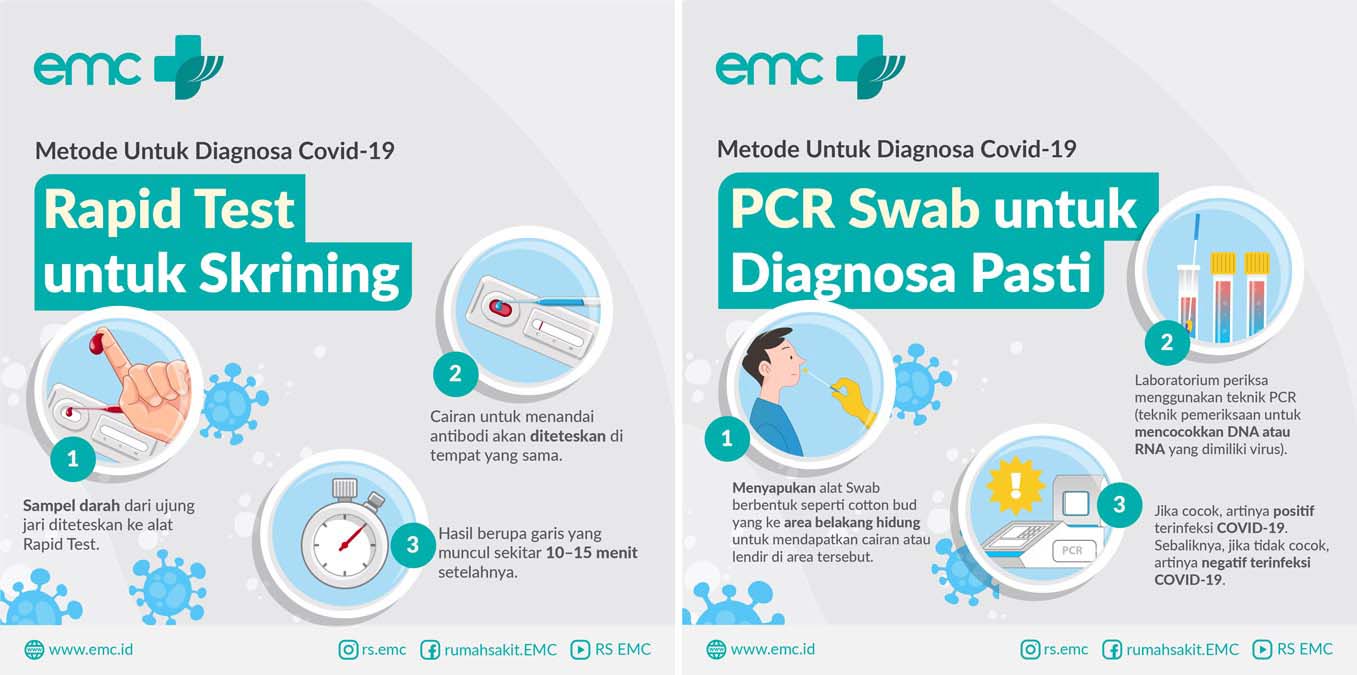
During the COVID-19 pandemic like now, it's only natural that we are worried about getting the corona virus, especially for vulnerable groups who are at risk of experiencing a heavy impact from this disease. So that we and our families can be more calm and protected from the threat of the corona virus, apart from preventing transmission, it is also important to do tests so that we can detect whether or not the corona virus is in our bodies.
Currently, there are two methods that can be used to detect the corona virus, namely the rapid test and the PCR ( Polymerase Chain Reaction ) swab test . Although both are used to detect the corona virus, the two tests have some differences. Anything? Check out the differences and the procedure below:
inspection purpose
- Rapid Test for Screening.

- PCR Swab for definitive diagnosis.

Sample type
One of the differences from the PCR swab and rapid test is the type of sample taken. A rapid test is carried out by taking a blood sample. The rapid test method checks for the virus using IgG and IgM antibodies in the blood. These antibodies are formed in the body when we experience a viral infection. So, if a virus infection occurs in our body, then the amount of IgG and IgM in the body will increase. The results of this rapid test can show the presence of IgG or IgM in the blood. If there is, then the results of the rapid test are declared reactive for a virus infection.
However, these results are not a definitive diagnosis that describes COVID-19 infection. So, if someone with reactive or non-reactive rapid test results will be advised to undergo further examination, namely PCR swab examination. PCR swab examination uses mucus samples taken from inside the nose and throat. These two areas were chosen because they are places where the virus multiplies itself. This examination is considered more accurate, because the corona virus will stick to the inside of the nose or throat when it enters the body. The final results of the PCR swab examination will later really show the presence of the SARS-COV2 virus in a person's body.
Examination result time
The rapid test only takes 10-15 minutes for the test results to come out, while the examination using the PCR swab method takes several hours to several days to show the results.
The advantages and disadvantages of both test methods
One of the advantages of the rapid test is its speed and convenience. This method can also be an alternative to quickly record people who need follow-up examinations. The drawback is that the results of this rapid test can be used to test for the presence or absence of the virus in the body but cannot be used directly to diagnose COVID-19 for sure.
Then, the advantage of the PCR swab examination is its accuracy in detecting the corona virus. However, the drawback of this method is that the examination is a bit more complicated and requires a longer time.
Examination procedure

The rapid test examination procedure begins by taking a blood sample from the fingertip which is then dripped into the rapid test tool. Next, the liquid to mark the antibodies will be dripped in the same place. The result will be a line that appears 10–15 minutes later.
Meanwhile, for the stage of the swab test examination procedure using the PCR method, the health worker will insert a Swab tool that is shaped like a cotton bud which is carried out to sweep the tool over the area behind the nose to get fluid or mucus in that area.
After that, the swab tool will be inserted into a special tube and closed. This specimen is then sent to the laboratory for examination using the PCR technique. PCR is an examination technique that is carried out to match the DNA or RNA that the virus has. The DNA or RNA in the sample from the swab will be replicated or duplicated as much as possible. Then it was matched with the SARS-COV2 DNA sequence as a template. If they match, then the patient whose mucus sample was taken is positive for COVID-19. Conversely, if it turns out they don't match, it's a sign that the person is negatively infected with COVID-19.
Check now for a better tomorrow! click this link for details regarding the PCR Swab at the EMC Hospital.
Also read: EMC Home Visit Service Easy and Convenient Solution for Doing PCR Swabs at Home
Is the Omicron Covid-19 Variant more dangerous than the Delta Variant? Know the Facts
